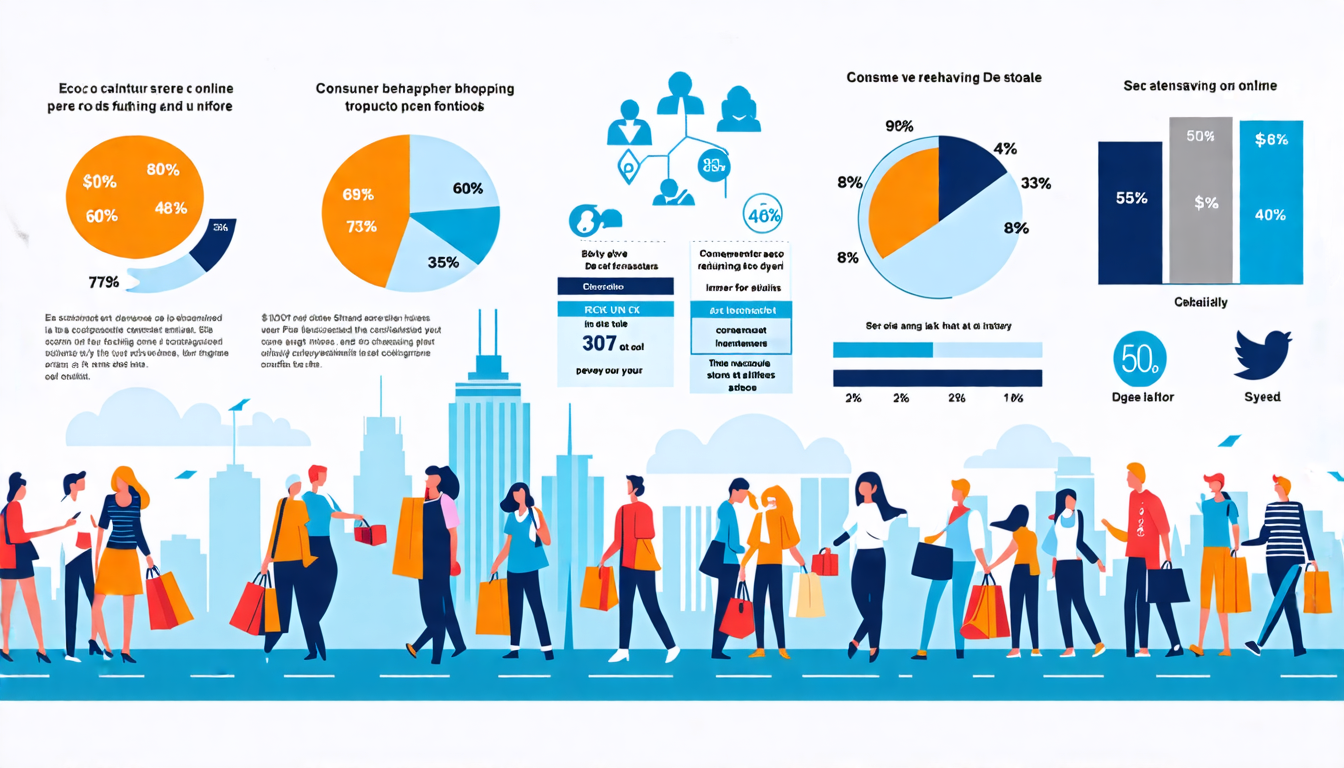In today’s rapidly evolving marketplace, understanding consumer behavior has become crucial for businesses striving to stay competitive. Consumer behavior refers to the actions and decision-making processes of individuals and groups when they select, purchase, and use products and services. Grasping these patterns is vital for developing effective market strategies that resonate with target audiences. Various factors influence consumer behavior, including cultural, social, personal, and psychological elements. These factors shape how consumers perceive products, form preferences, and make purchasing decisions.
Presently, several emerging trends are reshaping consumer behavior analysis. Foremost among these is the impact of digitalization. Advances in technology have revolutionized the way consumers interact with brands, making online experiences a pivotal factor in purchasing decisions. Additionally, social media and influencer marketing have grown significantly in their role, dictating buying patterns and preferences. These platforms provide consumers with instant access to reviews, recommendations, and social proof, fundamentally altering traditional pathways to purchase. By staying attuned to these trends, businesses can better align their strategies with evolving consumer landscapes, ensuring sustained relevance and engagement.
Understanding the Basics of Consumer Behavior
Define Consumer Behavior and Its Importance in Market Strategy
Consumer behavior refers to the study of how individuals, groups, or organizations make decisions regarding the purchase, use, and disposal of goods and services. Understanding consumer behavior is critical for businesses as it helps them design effective marketing strategies, predict future demand, and stay competitive in the market.
At its core, consumer behavior analysis involves examining various aspects such as buying patterns, preferences, and influences that drive consumers to make particular choices. This analysis allows businesses to tailor their products, services, and marketing campaigns to meet the specific needs and desires of their target audience, thus enhancing customer satisfaction and loyalty.
Key Factors Influencing Consumer Behavior (Cultural, Social, Personal, and Psychological)
Cultural Factors
Cultural factors encompass the values, beliefs, and norms that shape an individual’s behavior within a society. These factors have a profound impact on consumption habits and preferences. For instance, cultural contexts can dictate the types of products that are considered acceptable or desirable. Understanding cultural nuances allows businesses to customize their offerings and messages to resonate with a specific demographic.
Social Factors
Social factors include the influence of family, friends, social networks, and other societal groups on an individual’s buying decisions. People often make purchasing decisions based on the recommendations and opinions of others. Social proof, such as customer reviews and testimonials, plays a vital role in this aspect. For businesses, harnessing social influences through effective word-of-mouth campaigns and leveraging social proof can significantly enhance their marketing efforts.
Personal Factors
Personal factors refer to the individual characteristics that influence consumer behavior, including age, gender, occupation, lifestyle, and economic status. These factors determine an individual’s preferences and their ability to purchase certain products. By segmenting the market based on personal characteristics, businesses can create more targeted and relevant marketing campaigns that appeal to specific customer groups.
Psychological Factors
Psychological factors encompass the internal processes that affect consumer choices, such as motivation, perception, learning, beliefs, and attitudes. For instance, consumers may be motivated by different needs (e.g., physiological, safety, social) and these motivations influence their buying behavior. Understanding these psychological drivers helps businesses craft compelling marketing messages and develop products that cater to the underlying motivations of their customers.

Current Trends in Consumer Behavior Analysis
The Impact of Digitalization on Consumer Preferences and Decision-Making
In today’s fast-paced world, digitalization has dramatically transformed the landscape of consumer preferences and decision-making. With the advent of e-commerce platforms, consumers now have the convenience of exploring and purchasing products from the comfort of their homes. This shift has led to a significant change in how businesses approach their marketing strategies.
Data analytics plays a crucial role in understanding consumer behavior in the digital age. Companies can track online activities, such as browsing habits, purchase history, and even time spent on specific pages. This wealth of data enables businesses to create highly personalized marketing campaigns that resonate with individual preferences.
Furthermore, the rise of mobile technology has altered the way consumers interact with brands. Smartphones and tablets provide instant access to information, reviews, and price comparisons. As a result, consumers are more informed and selective about their purchases. Brands need to ensure their online presence is optimized for mobile devices to capture this savvy audience.
The importance of a seamless and efficient online shopping experience cannot be overstated. User-friendly websites, fast loading times, and secure payment gateways are essential elements that influence consumer decisions. In addition, the integration of artificial intelligence (AI) and machine learning technologies allows brands to predict and anticipate consumer needs, further refining their marketing efforts.
Overall, digitalization has empowered consumers, making them more discerning and demanding. Businesses must leverage digital tools and strategies to stay relevant and meet the evolving expectations of their target audience.
The Role of Social Media and Influencer Marketing in Shaping Buying Patterns
Social media has emerged as a powerful tool in shaping consumer behavior. Platforms like Facebook, Instagram, Twitter, and TikTok provide brands with direct channels to engage with their audience. The interactive nature of social media allows consumers to voice their opinions, share experiences, and connect with brands on a personal level.
One of the most significant trends in recent years is the rise of influencer marketing. Influencers, with their dedicated followers, have become key players in promoting products and services. Their recommendations often carry more weight than traditional advertising methods due to their perceived authenticity and relatability. Consumers view influencers as trusted sources, making their endorsements highly influential in the decision-making process.
Brands collaborate with influencers to reach specific demographics, drive brand awareness, and boost sales. These partnerships can take various forms, including product reviews, sponsored posts, giveaways, and exclusive discount codes. The success of influencer marketing lies in its ability to create relatable and engaging content that resonates with the audience.
Social proof, a psychological phenomenon where people mimic the actions of others, plays a critical role in social media marketing. When consumers see influencers using a product or service, they are more likely to try it themselves. User-generated content, such as customer reviews and testimonials, further amplifies this effect by providing real-world examples of product experiences.
Moreover, social media analytics offer valuable insights into consumer behavior. Metrics like engagement rates, shares, comments, and likes help brands gauge the effectiveness of their campaigns and identify trends. This data-driven approach allows for continuous refinement of marketing strategies, ensuring they remain relevant and impactful.
In conclusion, the interplay between social media and influencer marketing has revolutionized consumer behavior. Brands must leverage these platforms to build strong, authentic connections with their audience, ultimately influencing their buying decisions.
In conclusion, understanding consumer behavior is paramount for developing effective market strategies. By comprehensively examining the factors that influence consumer choices—cultural, social, personal, and psychological—businesses can tailor their approaches to better meet the needs and preferences of their target audience.
The rapid advancement of digitalization has significantly altered consumer behavior patterns. Digital platforms have become a central channel through which consumers discover, evaluate, and purchase products. This digital shift necessitates that businesses adapt to new modes of engagement and decision-making processes.
Additionally, the rise of social media and influencer marketing has reshaped traditional buying patterns. Consumers are increasingly relying on the opinions and endorsements of influencers, which play a crucial role in their purchase decisions. Brands that effectively leverage these platforms and partnerships are more likely to capture the attention and loyalty of their consumers.
Ultimately, keeping up with these evolving trends in consumer behavior is essential for businesses aiming to stay competitive in today’s dynamic market landscape. By continuously analyzing and adapting to these trends, companies can ensure they remain relevant and successful in meeting the ever-changing demands of their customers.

